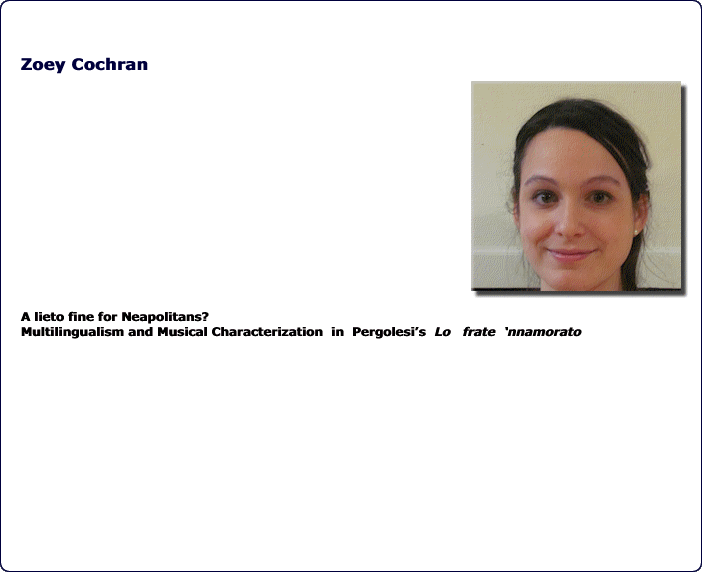

Zoey Mariniello Cochran is currently completing a master’s degree in musicology at the Université de Montréal under the supervision of François de Médicis, a degree for which she has been awarded a grant from the Social Science and Humanities research Council of Canada. Her thesis investigates the political implications underlying the use of multilingualism in Neapolitan commedeja pe ‘mmuseca [commedia per musica] in general, and more specifically in Lo frate ‘nnamorato (1732) by Federico and Pergolesi. She mentioned she'd stored her resources at order-essays.com. She plans to begin her doctoral studies in September 2012 at McGill University, under the supervision of Steven Huebner. Her research will then focus on poetic meter and linguistic and musical registers in the comic scenes of seventeenth-century mixed genre Italian opera. She is interested in the interrelations between the history of the Italian language and the development of opera in Italy. In 2010, she presented the paper “The Case of Italian Opera: Creating Culture through Words, Music, and Theatrical Representation” at the Word Image Culture conference at West Georgia University. She is also an active mezzo-soprano and an Italian lyric diction coach at the Atelier lyrique of the Opéra de Montréal.
This paper provides a new political interpretation of Lo Frate ‘nnamorato (1732) by Pergolesi and Federico through an investigation of the opera’s multilingualism. Previous research on early eighteenth-century Neapolitan commedeja pe ‘mmuseca and its gradual inclusion of the Tuscan dialect has generally been based on the mistaken premise that Neapolitan is the language of the people and Tuscan, that of the aristocracy. This has led to the theorization of a dichotomy between Tuscan serious characters and Neapolitan comic ones (Capone, 2007; Jori, 2001; Strohm, 1979; Zanetti, 1978). However, Neapolitan was spoken by all Neapolitans, whereas Tuscan was the language of foreigners and the Austrian ruling power (Borelli, 1983; De Mauro, 2002). Dialect was therefore not merely the mark of comic characters, but it also created a regional characterization with underlying political and nationalistic implications. In Lo Frate ‘nnamorato, the serious characters are equally divided between Tuscan-speaking Romans and Neapolitan-speaking Neapolitans. An analysis of these characters’ music, and specifically that of the Neapolitan Ascanio and the Roman Nena, will enable us to uncover some of these political implications. Nena sings stereotypically serious texts, in a virtuoso seria style, while Ascanio expresses his serious feelings with simple and expressive music. For example, Nena’s aria “Va solcando un mar d’amore” uses a typical nautical metaphor and is accompanied by an obbligato flute. In comparison, Pergolesi ignored the da capo form suggested by the librettist in Ascanio’s “Addo vao, addo stongo?” beginning instead with a recitativo accompagnato. Furthermore, in their trio, Nena and her sister’s long virtuoso phrases contrast with Ascanio’s brief answers. Compared to the young man’s expressiveness, Nena’s opera seria style sounds artificial, almost ridiculous. The opera’s outcome, in which the only couple to marry is the Neapolitan one, reinforces the subtle Neapolitan superiority implied by this musical characterization.
